Just-in-Time Correntropy Soft Sensor with Noisy Data for Industrial Silicon Content Prediction
Abstract
:1. Introduction
2. CSVR-Based Soft Sensor Model
3. Correntropy-Based Local Modeling and Prediction Method
3.1. JCSVR-Based Local Model
3.2. Implementations of the Proposed Method
- Step 1.
- Collect the process input and output data, i.e.,, for training of the CSVR model.
- Step 2.
- Train a CSVR model using the common cross-validation training strategy [46]. The weights can be obtained simultaneously. Then normalize all the weights into the range of [0, 1]. Using Equation (4) to identify the outliers and assign them into a outlier set . The relative clean dataset can be denoted as .
- Step 3.
- Applying a simple fuzzy c-means (FCM) clustering approach [49] to , the training samples are clustered into l sub-classes, denoted as . For , each sub-class has a center denoted as .
- Step 4.
- For online prediction of a new input measurement , judge which center of the sub-classes is its nearest one. If is the nearest to , only search the similar set in using the similarity criterion (Equations (5) and (6)). A JCSVR model for can be online constructed and the prediction is obtained.
- Step 5.
- If new training data are available, combine these data into (i.e., ) and go to step 1. Otherwise, go to step 4 and repeat the same procedure for online prediction of another new input .
4. Industrial Silicon Content Prediction
5. Conclusions
Acknowledgments
Author Contributions
Conflicts of Interest
Abbreviations
| CSF | Cumulative Similarity Factor |
| CSVR | Correntropy Support Vector Regression |
| HR | Hit Rate |
| JCSVR | Just-in-time Correntropy Support Vector Regression |
| JLSSVR | Just-in-time Least Squares Support Vector Regression |
| LSSVR | Least Squares Support Vector Regression |
| RE | Relative root-mean-square Error |
| RMSE | Root Mean Square Error |
| SI | Similarity Index |
| SVR | Support Vector Regression |
References
- Wijk, O.; Torssell, K.; Bl, X.; Torssell, K.; Wijk, O. Prediction of the blast furnace process by a mathematical model. ISIJ Int. 1992, 32, 481–488. [Google Scholar]
- Sugawara, K.; Morimoto, K.; Sugawara, T.; Dranoff, J.S. Dynamic behavior of iron forms in rapid reduction of carbon-coated iron ore. AIChE J. 1999, 45, 574–580. [Google Scholar] [CrossRef]
- Radhakrishnan, V.R.; Ram, K.M. Mathematical model for predictive control of the bell-less top charging system of a blast furnace. J. Process. Control. 2001, 11, 565–586. [Google Scholar] [CrossRef]
- Nogami, H.; Chu, M.; Yagi, J.I. Multi-dimensional transient mathematical simulator of blast furnace process based on multi-fluid and kinetic theories. Comput. Chem. Eng. 2005, 29, 2438–2448. [Google Scholar] [CrossRef]
- Nishioka, K.; Maeda, T.; Shimizu, M. A three-dimensional mathematical modelling of drainage behavior in blast furnace hearth. ISIJ Int. 2005, 45, 669–676. [Google Scholar] [CrossRef]
- Ueda, S.; Natsui, S.; Nogami, H.; Jun-Ichiro, Y.; Ariyama, T. Recent progress and future perspective on mathematical modeling of blast furnace. ISIJ Int. 2010, 50, 914–923. [Google Scholar] [CrossRef]
- Singh, H.; Sridhar, N.V.; Deo, B. Artificial neural nets for prediction of silicon content of blast furnace hot metal. Steel Res. Int. 1996, 67, 521–526. [Google Scholar] [CrossRef]
- Radhakrishnan, V.R.; Mohamed, A.R. Neural networks for the identification and control of blast furnace hot metal quality. J. Process. Control. 2000, 10, 509–524. [Google Scholar] [CrossRef]
- Chen, J. A predictive system for blast furnaces by integrating a neural network with qualitative analysis. Eng. Appl. Artif. Intell. 2001, 14, 77–85. [Google Scholar] [CrossRef]
- Jimenez, J.; Mochon, J.; Sainz, D.A.J.; Obeso, F. Blast furnace hot metal temperature prediction through neural networks-based models. ISIJ Int. 2007, 44, 573–580. [Google Scholar] [CrossRef]
- Saxen, H.; Pettersson, F. Nonlinear prediction of the hot metal silicon content in the blast furnace. ISIJ Int. 2007, 47, 1732–1737. [Google Scholar] [CrossRef]
- Pettersson, F.; Chakraborti, N.; Saxén, H. A genetic algorithms based multi-objective neural net applied to noisy blast furnace data. Appl. Soft Comput. 2007, 7, 387–397. [Google Scholar] [CrossRef]
- Nurkkala, A.; Pettersson, F.; Saxén, H. Nonlinear modeling method applied to prediction of hot metal silicon in the ironmaking blast furnace. Ind. Eng. Chem. Res. 2011, 50, 9236–9248. [Google Scholar] [CrossRef]
- Hao, X.; Shen, F.; Du, G.; Shen, Y.; Xie, Z. A blast furnace prediction model combining neural network with partial least square regression. Steel Res. Int. 2005, 76, 694–699. [Google Scholar] [CrossRef]
- Bhattacharya, T. Prediction of silicon content in blast furnace hot metal using partial least squares (PLS). ISIJ Int. 2005, 45, 1943–1945. [Google Scholar] [CrossRef]
- And, M.W.; Saxén, H. On the development of predictive models with applications to a metallurgical process. Ind. Eng. Chem. Res. 2000, 39, 982–988. [Google Scholar]
- Gao, C.; Zhou, Z.; Chen, J. Assessing the predictability for blast furnace system through nonlinear time series analysis. Ind. Eng. Chem. Res. 2008, 47, 3037–3045. [Google Scholar] [CrossRef]
- Waller, M.; Saxen, H. Application of nonlinear time series analysis to the prediction of silicon content of pig iron. ISIJ Int. 2002, 42, 316–318. [Google Scholar] [CrossRef]
- Miyano, T.; Kimoto, S.; Shibuta, H.; Nakashima, K.; Ikenaga, Y.; Aihara, K. Time series analysis and prediction on complex dynamical behavior observed in a blast furnace. Phys. D: Nonlinear Phenom. 2000, 135, 305–330. [Google Scholar] [CrossRef]
- Martin, R.D.; Obeso, F.; Mochon, J.; Barea, R.; Jimenez, J. Hot metal temperature prediction in blast furnace using advanced model based on fuzzy logic tools. Ironmak. Steelmak. 2007, 34, 241–247. [Google Scholar] [CrossRef]
- Zeng, J.S.; Gao, C.H. Improvement of identification of blast furnace ironmaking process by outlier detection and missing value imputation. J. Process. Control. 2009, 19, 1519–1528. [Google Scholar] [CrossRef]
- Jian, L.; Gao, C.; Xia, Z. A sliding-window smooth support vector regression model for nonlinear blast furnace system. Steel Res. Int. 2011, 82, 169–179. [Google Scholar] [CrossRef]
- Gao, C.; Jian, L.; Luo, S. Modeling of the thermal state change of blast furnace hearth with support vector machines. IEEE Trans. Ind. Electron. 2012, 59, 1134–1145. [Google Scholar] [CrossRef]
- Jian, L.; Shen, S.; Song, Y. Improving the solution of least squares support vector machines with application to a blast furnace system. J. Appl. Math. 2012, 2012, 12. [Google Scholar] [CrossRef]
- Liu, Y.; Gao, Z. Enhanced just-in-time modelling for online quality prediction in bf ironmaking. Ironmak. Steelmak. 2015, 42, 321–330. [Google Scholar] [CrossRef]
- Gao, C.; Chen, J.; Zeng, J.; Liu, X.; Sun, Y. A chaos-based iterated multistep predictor for blast furnace ironmaking process. AIChE J. 2009, 55, 947–962. [Google Scholar] [CrossRef]
- Luo, S.; Gao, C.; Zeng, J.; Huang, J. Blast furnace system modeling by multivariate phase space reconstruction and neural networks. Asian J. Control. 2013, 15, 553–561. [Google Scholar] [CrossRef]
- Gao, C.; Zeng, J.; Zhou, Z. Identification of multiscale nature and multiple dynamics of the blast furnace system from operating data. AIChE J. 2011, 57, 3448–3458. [Google Scholar] [CrossRef]
- Chu, Y.; Gao, C. Data-based multiscale modeling for blast furnace system. AIChE J. 2014, 60, 2197–2210. [Google Scholar] [CrossRef]
- Nurkkala, A.; Pettersson, F.; Saxén, H. A study of blast furnace dynamics using multiple autoregressive vector models. ISIJ Int. 2012, 52, 1763–1770. [Google Scholar] [CrossRef]
- Saxén, H.; Gao, C.; Gao, Z. Data-driven time discrete models for dynamic prediction of the hot metal silicon content in the blast furnace—A review. IEEE Trans. Ind. Inform. 2013, 9, 2213–2225. [Google Scholar] [CrossRef]
- Kano, M.; Nakagawa, Y. Data-based process monitoring, process control, and quality improvement: Recent developments and applications in steel industry. Comput. Chem. Eng. 2008, 32, 12–24. [Google Scholar] [CrossRef] [Green Version]
- Kadlec, P.; Gabrys, B.; Strandt, S. Data-driven soft sensors in the process industry. Comput. Chem. Eng. 2009, 33, 795–814. [Google Scholar] [CrossRef]
- Zur, R.M.; Jiang, Y.; Pesce, L.L.; Drukker, K. Noise injection for training artificial neural networks: A comparison with weight decay and early stopping. Med. Phys. 2009, 36, 4810–4818. [Google Scholar] [CrossRef] [PubMed]
- Arbabi, V.; Pouran, B.; Campoli, G.; Weinans, H.; Zadpoor, A.A. Determination of the mechanical and physical properties of cartilage by coupling poroelastic-based finite element models of indentation with artificial neural networks. J. Biomech. 2016, 49, 631–637. [Google Scholar] [CrossRef] [PubMed]
- Arbabi, V.; Pouran, B.; Weinans, H.; Zadpoor, A.A. Combined inverse-forward artificial neural networks for fast and accurate estimation of the diffusion coefficients of cartilage based on multi-physics models. J. Biomech. 2016, 49, 2799–2805. [Google Scholar] [CrossRef] [PubMed]
- Liu, H.; Shah, S.; Jiang, W. Online outlier detection and data cleaning. Comput. Chem. Eng. 2004, 28, 1635–1647. [Google Scholar] [CrossRef]
- Pearson, R.K. Outliers in process modeling and identification. IEEE Trans. Control. Syst. Technol. 2002, 10, 55–63. [Google Scholar] [CrossRef]
- Chiang, L.H.; Pell, R.J.; Seasholtz, M.B. Exploring process data with the use of robust outlier detection algorithms. J. Process. Control. 2003, 13, 437–449. [Google Scholar] [CrossRef]
- Hodge, V.J.; Austin, J. A survey of outlier detection methodologies. Artif. Intell. Rev. 2004, 22, 85–126. [Google Scholar] [CrossRef]
- Fujiwara, K.; Kano, M.; Hasebe, S.; Takinami, A. Soft-sensor development using correlation-based just-in-time modeling. AIChE J. 2009, 55, 1754–1765. [Google Scholar] [CrossRef]
- Bontempi, G.; Birattari, M.; Bersini, H. Lazy learning for local modelling and control design. Int. J. Control. 1999, 72, 643–658. [Google Scholar] [CrossRef]
- Cheng, C.; Chiu, M.S. A new data-based methodology for nonlinear process modeling. Chem. Eng. Sci. 2004, 59, 2801–2810. [Google Scholar] [CrossRef]
- Liu, Y.; Chen, J. Integrated soft sensor using just-in-time support vector regression and probabilistic analysis for quality prediction of multi-grade processes. J. Process. Control. 2013, 23, 793–804. [Google Scholar] [CrossRef]
- Liu, W.; Pokharel, P.P.; Principe, J.C. Correntropy: Properties and applications in non-gaussian signal processing. IEEE Trans. Signal. Process. 2007, 55, 5286–5298. [Google Scholar] [CrossRef]
- Liu, Y.; Chen, J. Correntropy kernel learning for nonlinear system identification with outliers. Ind. Eng. Chem. Res. 2014, 53, 5248–5260. [Google Scholar] [CrossRef]
- Suykens, J.A.K.; Van Gestel, T.; De Brabanter, J.; De Moor, B.; Vandewalle, J. Least Squares Support Vector Machines; World Scientific: Singapore, 2002. [Google Scholar]
- Wen, W.; Hao, Z.; Yang, X. A heuristic weight-setting strategy and iteratively updating algorithm for weighted least-squares support vector regression. Neurocomputing 2008, 71, 3096–3103. [Google Scholar] [CrossRef]
- Miyamoto, S.; Ichihashi, H.; Honda, K. Algorithms for Fuzzy Clustering: Methods in c-Means Clustering with Applications; Springer: New York, NY, USA, 2008. [Google Scholar]
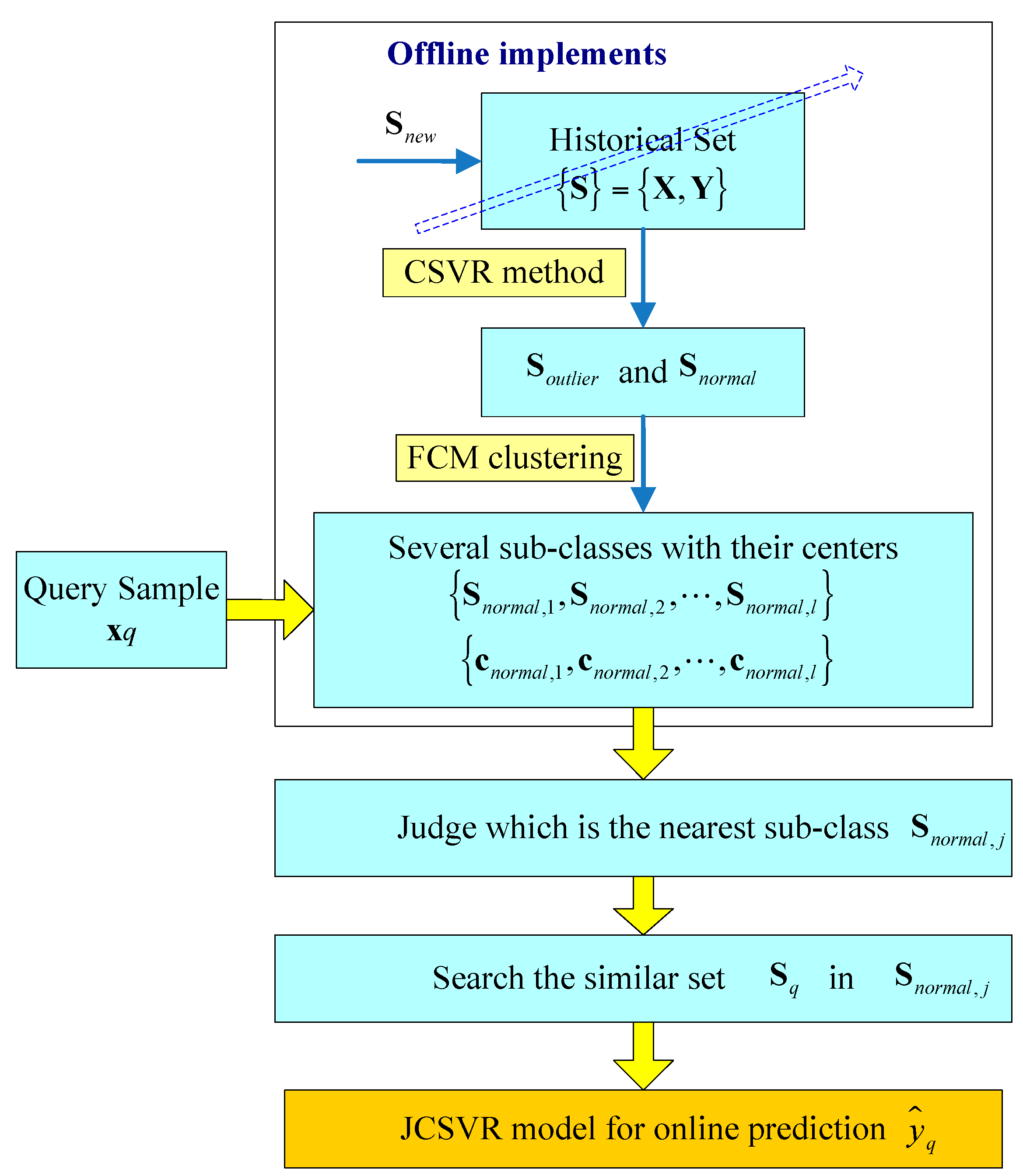
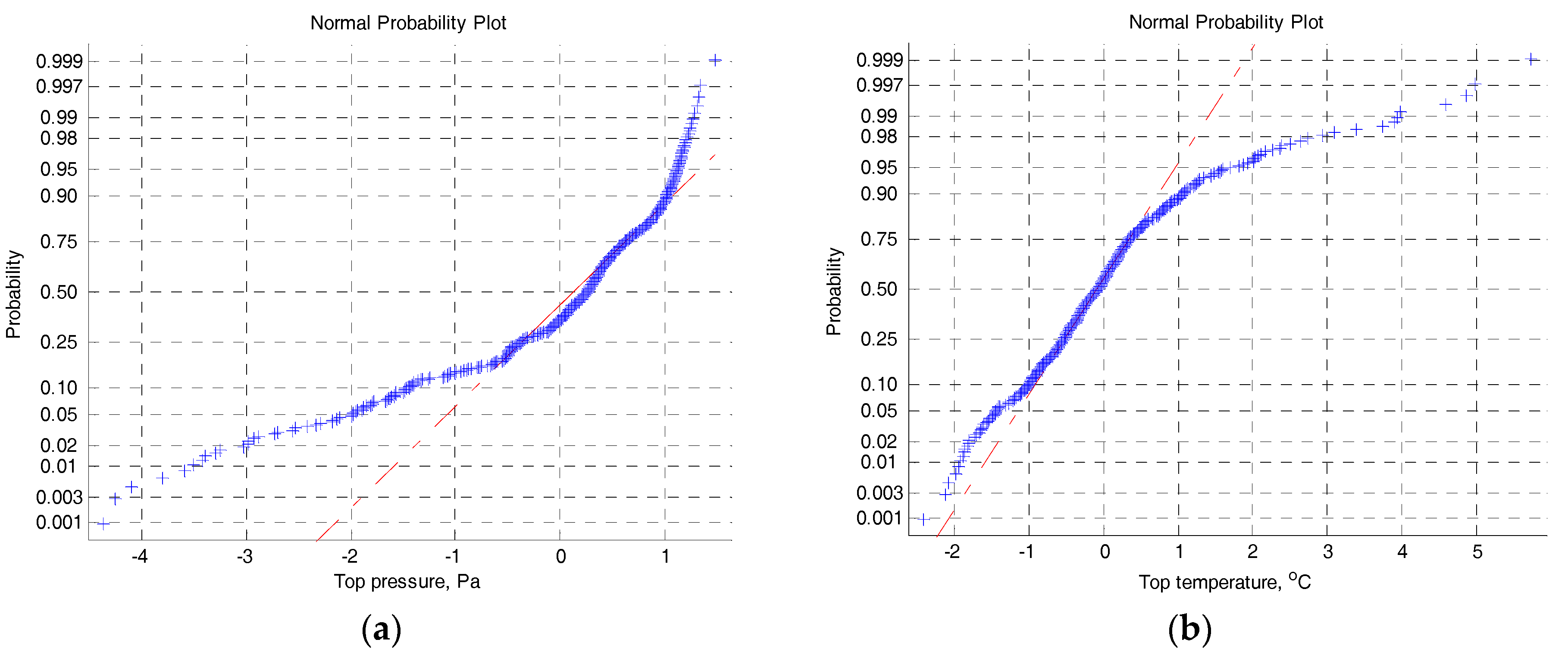
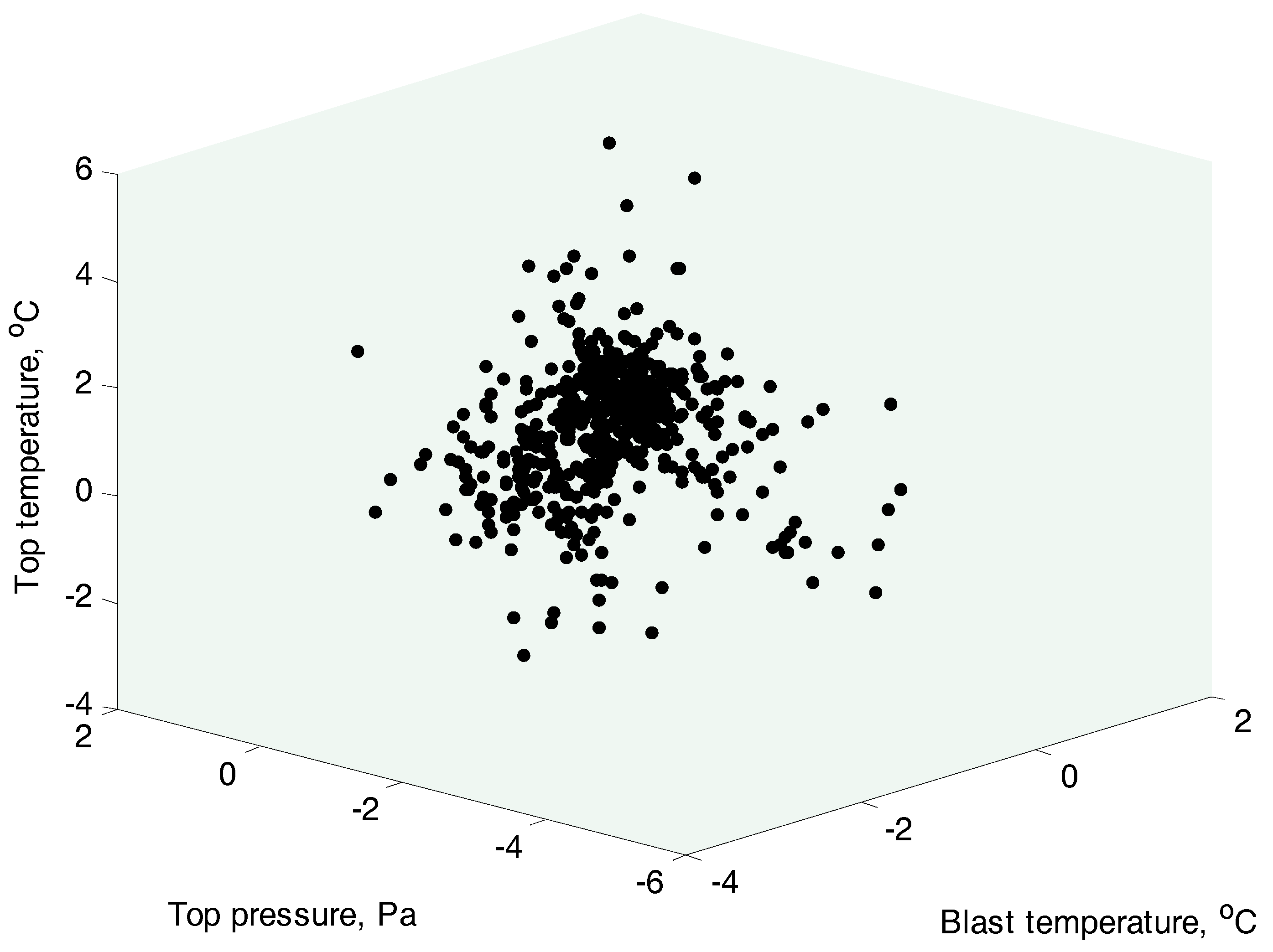

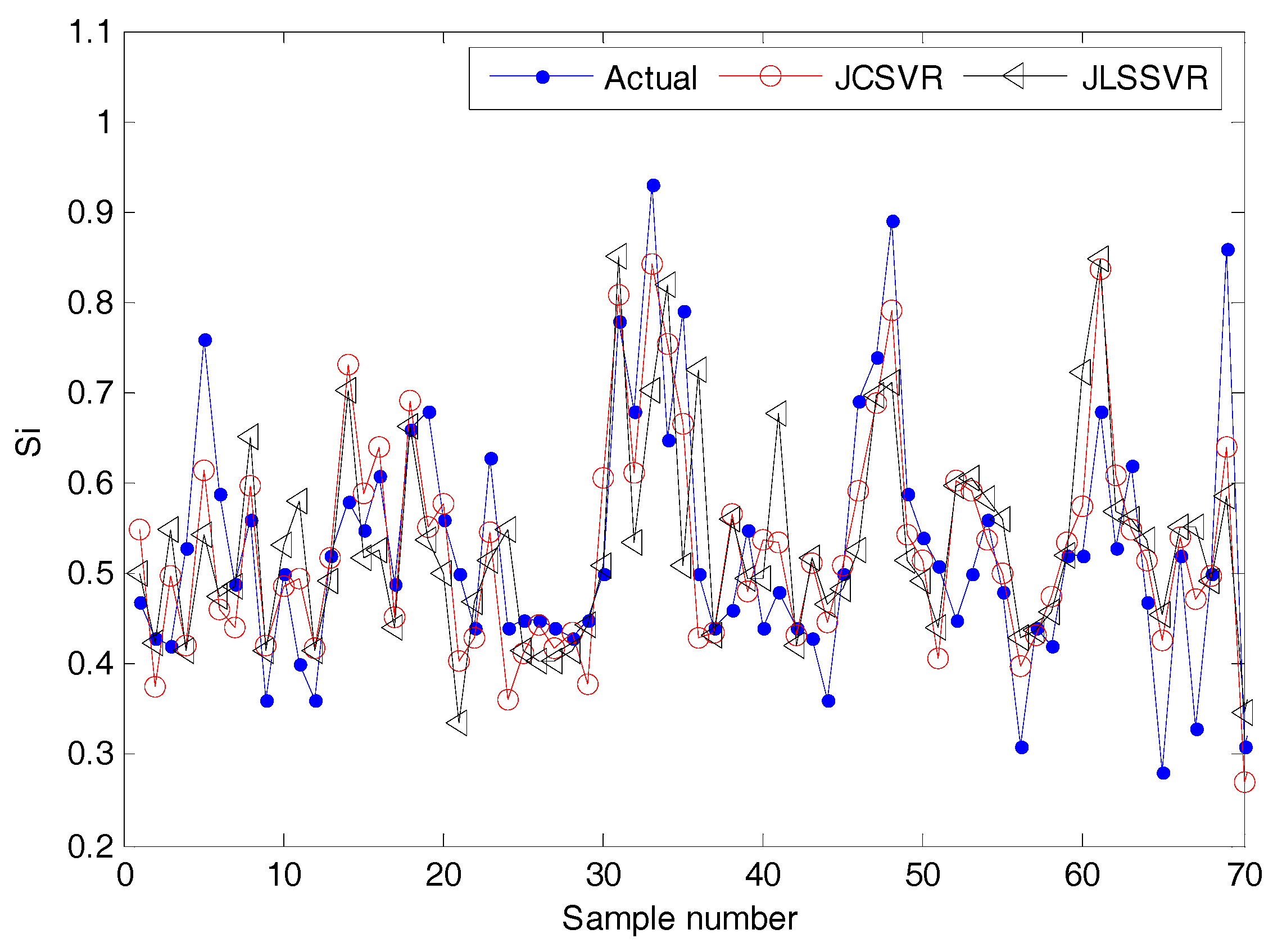
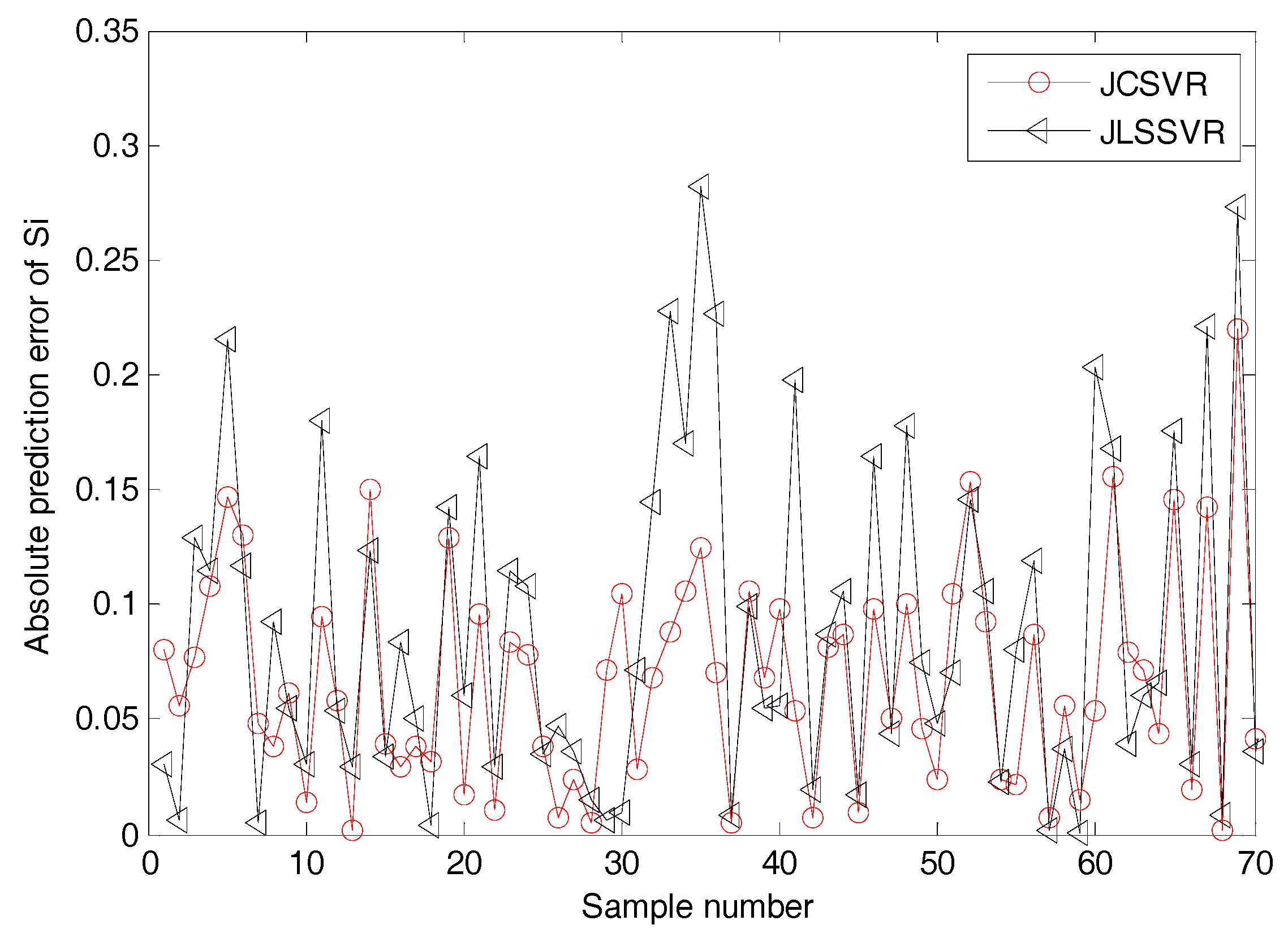
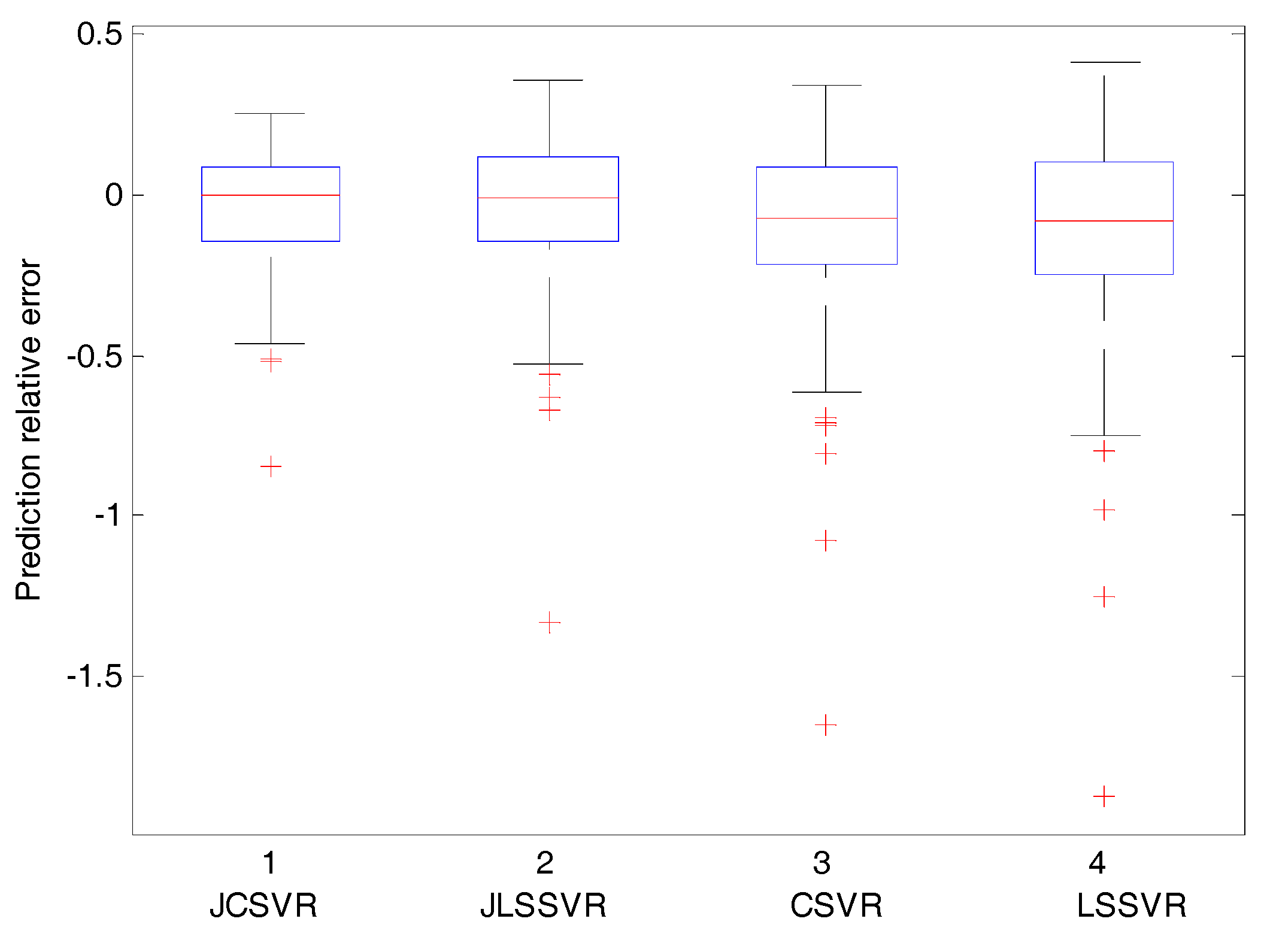
| Soft Sensor Model | RMSE | RE (%) | HR (%) |
|---|---|---|---|
| CSVR [46] | 0.116 | 21.49 | 73.33 |
| LSSVR [24,47] | 0.122 | 23.04 | 66.25 |
| Prediction Model | Brief Description | |||
|---|---|---|---|---|
| Local and Unfixed | Outlier Detection | Main Pros | Main Cons | |
| JCSVR | Yes | Yes | More suitable for noisy and uneven distributed data | Model selection is relatively difficult |
| JLSSVR [25] | Yes | No | Suitable for online modeling of nonlinear processes | Not robust for outliers |
| CSVR [46] | No | Yes | Suitable for construction of a global model with noisy data | Prediction accuracy for some local regions may not be enough |
| LSSVR [24,47] | No | No | A simple nonlinear modeling method | Not robust for outliers and relatively inaccurate for some local regions |
© 2017 by the authors. Licensee MDPI, Basel, Switzerland. This article is an open access article distributed under the terms and conditions of the Creative Commons Attribution (CC BY) license (http://creativecommons.org/licenses/by/4.0/).
Share and Cite
Chen, K.; Liang, Y.; Gao, Z.; Liu, Y. Just-in-Time Correntropy Soft Sensor with Noisy Data for Industrial Silicon Content Prediction. Sensors 2017, 17, 1830. https://doi.org/10.3390/s17081830
Chen K, Liang Y, Gao Z, Liu Y. Just-in-Time Correntropy Soft Sensor with Noisy Data for Industrial Silicon Content Prediction. Sensors. 2017; 17(8):1830. https://doi.org/10.3390/s17081830
Chicago/Turabian StyleChen, Kun, Yu Liang, Zengliang Gao, and Yi Liu. 2017. "Just-in-Time Correntropy Soft Sensor with Noisy Data for Industrial Silicon Content Prediction" Sensors 17, no. 8: 1830. https://doi.org/10.3390/s17081830




